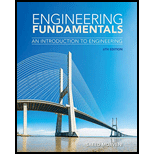
Concept explainers
(a)
Find the average strength-to-weight ratio for the aluminum alloy.
(a)
Answer to Problem 29P
The average strength-to-weight ratio for the aluminum alloy is
Explanation of Solution
Given data:
Use Table 17.3 in the textbook.
Specific weight of aluminum alloy is
Use Table 17.4 in the textbook.
Yield strength of aluminum alloy is
Calculation:
For Aluminum alloy:
Given,
Substitute
Substitute the unit
Thus, the average strength-to-weight ratio for the aluminum alloy is
Conclusion:
Hence, the average strength-to-weight ratio for the aluminum alloy is
(b)
Find the average strength-to-weight ratio for the titanium alloy.
(b)
Answer to Problem 29P
The average strength-to-weight ratio for the titanium alloy is
Explanation of Solution
Given data:
Use Table 17.3 in the textbook.
Specific weight of titanium alloy is
Use Table 17.4 in the textbook.
Yield strength of titanium alloy is
Calculation:
For titanium alloy:
Given,
Substitute
Substitute the unit
Thus, the average strength-to-weight ratio for the titanium alloy is
Conclusion:
Hence, the average strength-to-weight ratio for the titanium alloy is
(c)
Find the average strength-to-weight ratio for the steel.
(c)
Answer to Problem 29P
The average strength-to-weight ratio for the steel is
Explanation of Solution
Given data:
Use Table 17.3 in the textbook.
Specific weight of steel is
Use Table 17.4 in the textbook.
Yield strength of steel (structural) is
Calculation:
For steel:
Given,
Substitute
Substitute the unit
Thus, the average strength-to-weight ratio for the steel is
Conclusion:
Hence, the average strength-to-weight ratio for the steel is
Want to see more full solutions like this?
Chapter 17 Solutions
ENGINEERING FUNDAMENTALS
- Solve for forces on pin C and Darrow_forwardBorrow pit soil is being used to fill an 900,00 yd3 of depression. The properties of borrowpit and in-place fill soils obtained from laboratory test results are as follows:• Borrow pit soil: bulk density 105 pcf, moisture content = 8%, and specific gravity = 2.65• In-place fill soil: dry unit weight =120 pcf, and moisture content = 16%(a) How many yd3 of borrow soil is required?(b) What water mass is needed to achieve 16% moisture in the fill soil?(c) What is the in-place density after a long rain?arrow_forwardsolve for dt/dx=f(t,x)=x+t^2arrow_forward
- Calculate the BMs (bending moments) at all the joints of the beam shown in Fig.1 using the slope deflection method, draw the resulting shear force diagran and bending moment diagram. The beam is subjected to an UDL of w=65m. L=4.5m, L1= 1.8m. Assume the support at C is pinned, and A and B are roller supports. E = 200 GPa, I = 250x106 mm4.arrow_forwardProblem 2 (A is fixed and C is a pin) Find the reactions and A and C. 10 k- 6 ft 6 ft B A 2 k/ft 15 ftarrow_forward6. A lake with no outlet is fed by a river with a constant flow of 1200 ft3/s. Water evaporates from the surface at a constant rate of 13 ft3/s per square mile of surface area. The surface area varies with the depth h (in feet) as A (square miles) = 4.5 + 5.5h. What is the equilibrium depth of the lake? Below what river discharge (volume flow rate) will the lake dry up?arrow_forward
- Problem 5 (A, B, C and D are fixed). Find the reactions at A and D 8 k B 15 ft A -20 ft C 10 ft Darrow_forwardProblem 4 (A, B, E, D and F are all pin connected and C is fixed) Find the reactions at A, D and F 8 m B 6m E 12 kN D F 4 marrow_forwardProblem 1 (A, C and D are pins) Find the reactions and A, C and D. D 6 m B 12 kN/m 8 m A C 6 marrow_forward
- Uniform Grade of Pipe Station of Point A is 9+50.00. Elevation Point A = 250.75.Station of Point B is 13+75.00. Elevation Point B = 244.10 1) Calculate flowline of pipe elevations at every 50 ft. interval (Half Station). 2) Tabulate station and elevation for each station like shown on example 3) Draw Sketcharrow_forward40m 150N B 40marrow_forwardquantity surveyingarrow_forward
 Engineering Fundamentals: An Introduction to Engi...Civil EngineeringISBN:9781305084766Author:Saeed MoaveniPublisher:Cengage Learning
Engineering Fundamentals: An Introduction to Engi...Civil EngineeringISBN:9781305084766Author:Saeed MoaveniPublisher:Cengage Learning Materials Science And Engineering PropertiesCivil EngineeringISBN:9781111988609Author:Charles GilmorePublisher:Cengage Learning
Materials Science And Engineering PropertiesCivil EngineeringISBN:9781111988609Author:Charles GilmorePublisher:Cengage Learning Construction Materials, Methods and Techniques (M...Civil EngineeringISBN:9781305086272Author:William P. Spence, Eva KultermannPublisher:Cengage Learning
Construction Materials, Methods and Techniques (M...Civil EngineeringISBN:9781305086272Author:William P. Spence, Eva KultermannPublisher:Cengage Learning Fundamentals Of Construction EstimatingCivil EngineeringISBN:9781337399395Author:Pratt, David J.Publisher:Cengage,
Fundamentals Of Construction EstimatingCivil EngineeringISBN:9781337399395Author:Pratt, David J.Publisher:Cengage, Solid Waste EngineeringCivil EngineeringISBN:9781305635203Author:Worrell, William A.Publisher:Cengage Learning,
Solid Waste EngineeringCivil EngineeringISBN:9781305635203Author:Worrell, William A.Publisher:Cengage Learning,




